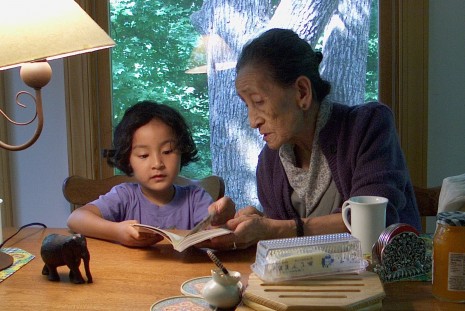
My mother, Lodey Lhawang (nee Tethong) passed away peacefully on the morning of January 9th, 2005, at my home in the mountains of Tennessee. There are only a few thousand Tibetans scattered around North America, so it was probably my mother’s “accrual of merit” (sonam saba), as we say, that somehow the great monastery of Drepung, specifically the Loseling College, had fortuitously located its only American branch in Atlanta, Georgia, a few hours drive away. Nine monks and a geshe, a doctor of divinity, drove up the mountain in their van, and for two days performed all the necessary prayer services and rituals at my home.
Some of the monks were young men who had recently escaped from Eastern Tibet where in the fifties violent and widespread uprisings had taken place against China’s military occupation. Decades earlier, the old Tibetan government had contested Republican and Warlord China’s incursions in these areas, with varying degrees of success. My mother’s father, Gyurme Gyatso Tethong, as a military man had been at the vanguard of these conflicts. My mother remembered as a child traveling with her father through these regions. A particularly momentous occasion was meeting the chieftains of Golok, the most warlike and feared confederation of nomad tribes in North Eastern Tibet. But my mother’ memories were of open grasslands and free and exciting people. In her own words:
When I was around nine years old my father took me to Dzachukha, the north-eastern limit of our frontier with Chinese-occupied Eastern Tibet. Two of the most powerful Golok chiefs were arriving there from their tribal lands further north and were to be awarded Tibetan government ranks and honours. I remember it all very clearly. The occasion was a welcome break from my normal routine of copying Tibetan alphabets on my wooden writing-board (jangshing) day after day, at Derge. I had started learning my letters a few years before and could now read whole sentences. When I was some years older and my writing had improved I was given the task of making copies of Tibetan government proclamations to circulate around the various district headquarters and monasteries in Eastern Tibet. That was when the 13th Dalai Lama appointed my father, Tethong Gyurme Gyatso, governor-general of the whole of Eastern Tibet.
But at the time of my trip to Dzachukha my father was only governor of Derge and shared administrative responsibilities with his uncle, Thangpon, who was co-governor. My father also commanded the Shigatse regiment. Thangpon commanded the Dhingri regiment. The Gyangtse regiment was under Chapay. Earlier my father’s co-governor had been his cousin, Khyungram, who had by then left for Lhasa.
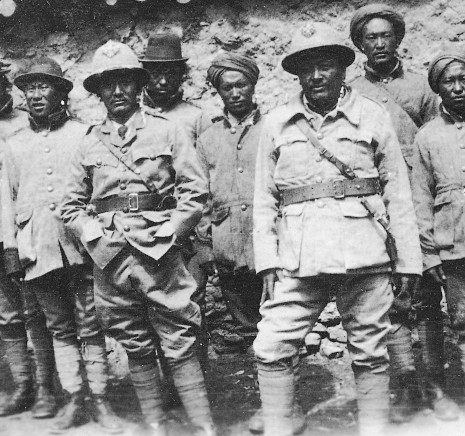
I was born in 1918, a month or so after the Chinese were defeated at Kanze. My father and his cousin Khyungram, both generals (dapon) at the time, had successfully driven out the Chinese forces from that area. The two generals were billeted at the home of an important chieftain of Kanze, Adug Lagatsang, and it was there that the Tibetan government courier (atrung) brought my father a letter from my mother, informing him of my birth in Lhasa city. Coincidentally, my uncle Khyungram also got a letter from Lhasa announcing the birth of a son to their family. As a military man I am sure my father was disappointed that his first child was a daughter, but he never so much as hinted about that to me. He was a very thoughtful and kind person. Some of the servants would tease me by saying how I had let down the Tethong family on that occasion. Later, I became good friends with Khyungram’s son. We were not only the same age but also cousins. Some years later when Khyungram was degraded and sent into exile because he had offended the Regent, his son, through no fault of his own, also lost his rank and wealth.
My father’s official career was mostly served in Eastern Tibet, about twenty years in all. He wanted to return to Central Tibet but was never relieved of his duties in Kham. The Thirteenth Dalai Lama was strong-willed and expected unquestioning obedience of his officials. My father was born in 1890. He married my mother, Dolma Tsering (née Rong Dekyiling) when he was twenty-seven and she only fifteen. There was a twelve year age difference between them. Both had the same astrological sign – the tiger.
I was born two years after the marriage. Four years later, when my father made a brief visit to Lhasa from Kham my sister Tsering Wangmo was born. A year later following another visit, my brother Tomjor was born. After that the whole family moved to Eastern Tibet and my brother Rakra Rinpoche was born in Derge. My sisters Sopal, Tsering Lhamo (who died young), and Tashi were born at Derge also. A brother Migmar Thondup was born to my mother at our estate in Shigatse when my father finally got to return to Central Tibet, but this child did not live long. My youngest brother Tsewang Chogyal was born in Chamdo during my father’s last tour of Eastern Tibet.
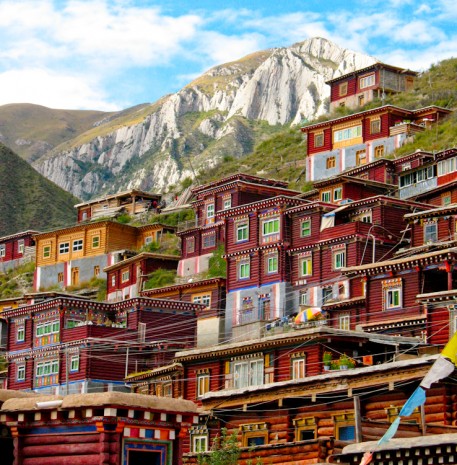
The Tibetan military headquarters and the civil administrative centre were at Derge Changra, which is on the other side (east) of the Drichu river. There were two military camps at Derge, one occupied by the Dhingri regiment and the other by the Shigatse and Gyangtse regiment. The camp of the Dhingri regiment was on a hill, about a mile-and-a-half from headquarters. The camps were permanent arrangements with administrative buildings and stores located at the centre and surrounded by barracks. The governor’s residence was a large castle nearby. It was a very old structure built of rammed earth and stone. Behind the castle was a park where we had picnics and archery contests. The castle had many rooms most of which were dark and gloomy. It was a high, cold building and the governor’s offices and residence were on the top, while at the bottom were dungeons where bandits and murderers were locked up. The castle was said to be haunted.
The first person to experience this was the artist Jamyang, a stout monk from Palpung monastery who my father had hired to paint some thankas scrolls for us. He had the ability to see spirits. He stayed in a small wooden hut at the top of the castle, where the national flag was flown. One day, looking down from the roof of the castle, he noticed some strange children playing outside the Gyangtse regiment camp. They did not appear every day but whenever they did it seemed that they were playing a little closer to the castle. Finally, they came inside. Immediately after that a rash of gambling, especially of the Chinese domino game thu bai chu, broke out among the soldiers. It got so bad that a soldier even sold his rifle to pay off his gambling debts. To restore discipline my father had all offenders punished and domino sets burnt. You see, the little children were actually theurang imps, and imps are known to be very fond of gambling. They are also mischievous and harmful.
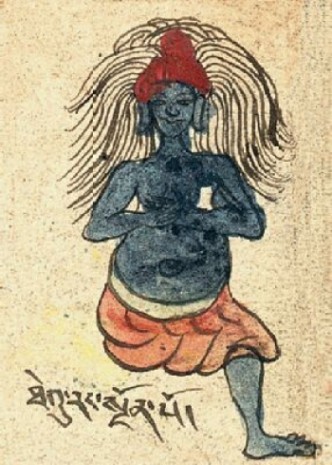
The famous Sakya lama, Khenpo Samten Lodroe, abbot of the great monastery of Derge, once stayed at the castle with some of his retainers to perform some religious services for us. One of his servants fell down a flight of stairs and died. The great lama became very angry and looked under the stairs as if he could see something or someone. He then ordered preparations for a fire-puja and performed a “wrathful” exorcism (drakpoe-jensik) and rid the place of the malicious imps.
We later moved to the residence of Tana dapon, who died in 1927 campaigning in Powo against the feudal baron of Powo, Kanam Depa, who had rebelled against the Central Government. The house was east of the castle and on the side of a low sunny hill. It was a cheerful house, two stories high in the front and one at the back. There was a large walled-courtyard in the front where the stables and store-houses were located. Later on the building was enlarged to accommodate the office of the governor.
From this headquarters in Derge the governors kept in touch with a number of small garrisons located all along the frontier with Chinese-occupied Kham. A military outpost manned by fifty soldiers from the Gyangtse regiment was maintained at Dzachukha. It was at this outpost where the Golok chiefs and their tribesmen were to gather to swear allegiance to the Dalai Lama and the Tibetan government, and receive official ranks and honours in return.
Our entire family accompanied my father on this expedition: my mother, my brother Tomjor, who was about six then, and another brother, an incarnate lama, Rakra Trulku, who was just a baby. They probably won’t remember anything about this journey. They were too young. I had a sister, Tsering Wangmo, who was about five, but she was in Lhasa under the care of my grandmother, from my mother’s family, the Dekyiling.
It was mid-summer when we set off. It is almost impossible to travel in those parts in winter. From Derge it took us about six to seven days to get to Dzachukha. I remember the first main stop we made was at Dankhog. “I have vivid memories of the landscape on the way: plunging gorges, high mountains and swift rivers – many rivers. It seemed to me that we were constantly fording a river or crossing a bridge, then getting to another river, crossing that and coming up against another. The names of those places were indicative of their nature – Khorlo–do, Dama–do (The “Wheel Confluence”, the “Drum Confluence”) and so on”.
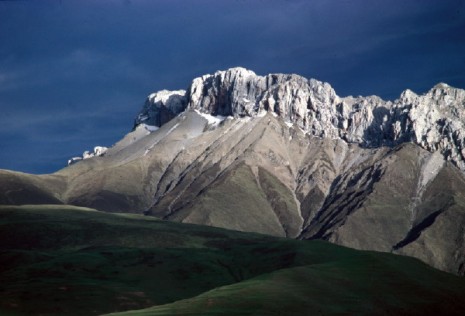
There were also gold prospectors along some stretches of these rivers. They were all poor Chinese coolies from Dartsedo, most of them opium smokers. They were employed by the governor of Derge to pan gold. The accumulated gold dust was sent to Lhasa to the Central Government. The king of Derge also had certain rights to extract gold from this area. The coolies pumped the sand up from the riverbed with equipment that looked like large tea-churns without bottoms.
On arriving at Dankhog I saw the monastery of Choengor-gon from a distance. It looked very grand and impressive, but I didn’t get to visit it. We stayed at the home of the 16th Karmapa’s father, Athup Tepo. His new house was just nearing completion, so we were lodged at his summer-house. It was designed like a Chinese temple and had a large pond with ducks and geese. We had an enjoyable stay there. Once the new house of the Athup-tsang was finished, they hosted a banquet for us. They borrowed our chef, Nyima, who was from our estate, Kharak, in Shigatse. Our major-domo, Grandfather Phuntsok, supervised the whole affair. He was the maternal uncle of our maid meme Sona. I remember attending the banquet. Gyalwa Karmapa was not there. I don’t know why. Probably he was sleeping. He was just a baby then – about three. But he was famous all over Kham. His mother and father were, of course, at the dinner. Whenever they came to Lhasa they would visit us, especially Tepo. He was a quiet, sober man of eminent respectability. He didn’t have any teeth and very little hair – but he had great dignity.
Our party had a military escort of about twenty-five soldiers. That was not counting members of the band: bagpipers, drummers and buglers. The soldiers who carried the national flag, regimental colours and the large banners of the protective deities were physically outstanding men. There were also those soldiers who fired the old Chinese mortar which signalled the arrival of important officials. Nine rounds were fired to announce the arrival of the governor.
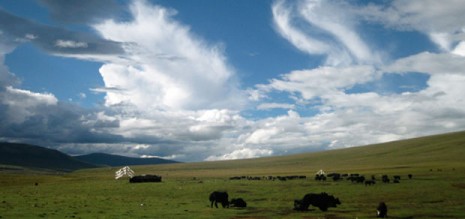
After Dankhog the landscape changed and the precipitous mountains and gorges gradually gave way to broad grassy plains. I remember galloping my pony wildly on such stretches. I had my very own pony – a small Tibetan pony brought all the way from Tsang. He was called Kyangtruk or baby “kyang” (the Tibetan wild ass). He was light brown in colour. I rode him everywhere. Whenever we traveled my father liked me to dress as a boy, which I really loved doing. So I wore a man’s robe with high boots and a charm-box (ghau) hanging from by shoulder. I even had a small sakchukha pistol (.22 Berreta) in a leather holster with a belt, tied securely around my waist.
My friend and companion was a servant girl, Phurbu Dolma, who was probably fourteen at the time. Whenever we got to a flat grassy stretch Phurbu Dolma and I would race our ponies. The younger servants would shout encouragements at us. But the older servants would later scold us for our wild behaviour. On the day that our party would arrive at an important stop, all the younger servants, maids, and us children would be sent early on ahead, so that our presence wouldn’t undermine the dignity of the ceremonial arrival of the governor of Derge.
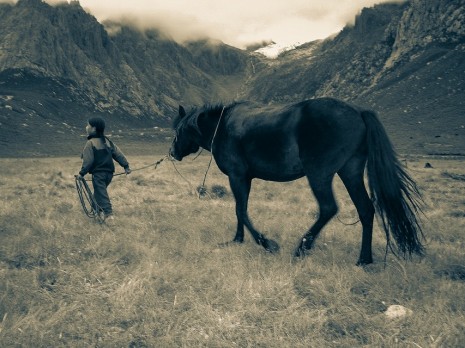
Just before reaching Dzachukha we came to the outpost of the Gyangtse regiment, manned by about fifty soldiers. The outpost, which looked like one of those US army forts in cowboy movies, came as a surprise to me. It was the only solid structure in the whole area. For the last few days all we had seen were the black tents of nomads and, and not many of them either. A little way from the fort, a large tent encampment had been prepared, and a reception committee arrived to escort us there. At the centre of the encampment tent-quarters had been prepared for the governor and his entourage.
I remember my mother telling me that the next day the Golok chiefs would receive government ranks. In one of the other tents our servants were unpacking and laying out the ceremonial costumes, indicative of official rank, to be presented to the two Golok chiefs. There were the yellow zogoe brocade robes, changda hats with red silk string fringe and turquoise crest, silk belts, boots, and the gya-dri pu-shuk knives. The chiefs were not issued the sogchil ear-rings as it was mandatory that you had long hair to wear one. Even when Golok men didn’t shave their heads altogether they kept their hair short.
The next day the ceremony took place in front of a large tent called a ta-summa (three-section). This kind of tent is rectangular and has one of the longer sides open and is used mostly for ceremonial purposes. It is made of white cotton and decorated with auspicious designs. Inside the tent, the ground of which was covered with many rugs, a throne was erected and a large photographic portrait of the 13th Dalai Lama in an ornate gilt frame belonging to our family, was placed on it.
Then the two chiefs rode up and dismounted. They were dressed in the ceremonial costumes that our servants had earlier taken over to their tents, and helped them put on. The servants later told us that when the chiefs tried to mount their horses the animals became skittish as they did not recognize their masters in their new outfits. One of the chiefs nearly got thrown-off. The two chieftains were accompanied by their lieutenants who were dressed in their traditional best.
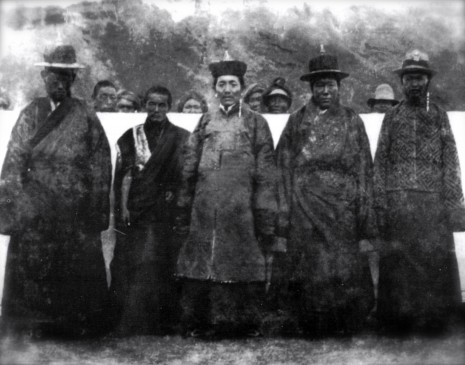
One of the chiefs was a thin man seemingly in his twenties, Trulku Tendrak of Golok Arkhyong Gongmatsang, chief of the Ri-mang tribes. The other, Rinchen Wang gi Gyalpo, was a stout man in his forties of dark, bluish complexion. He was chief of the Sershul nomads. They approached the throne and prostrated before it, and performed the other required formalities. They offered white silk khatak scarves to the portrait of the Dalai Lama and also to my father and the Golok lama Jampel Rolpai Lodroe who was also officiating at this ceremony. This thin, humble Gelukpa lama was respected and venerated by most Goloks. He was also well known in Lhasa for his scholarship. In fact it was his persistent advice and effort that had persuaded the two Golok chiefs that their lawless independent existence was a precarious one and that they should submit to the Tibetan government and once again become part of the nation with which they shared their religion and way of life. Jampel Rolpae Lodroe had also approached my father and, after some negotiations and letters to the Dalai Lama and the cabinet at Lhasa, the matter was arranged to everyone’s satisfaction.
After the sar-jel formalities, the prayer ritual for the long-life of His Holiness was performed. A proclamation from the Tibetan government was read out aloud conferring the fourth rank of rimshi on the two chiefs. Then our soldiers paraded to martial music from the band, and a number of rounds were fired from the Chinese mortars.
Many hundreds of Golok tribesmen and their women, the subjects of the two chiefs, had turned out for this occasion and the area around the ceremonial tent was covered, for miles around, with hundreds of black yak-hair tents. In the subsequent days, there were less and less tents, until one day there was no one else on that vast empty grassland but us. My mother told me that the tribesmen had probably gone off to raid caravans.
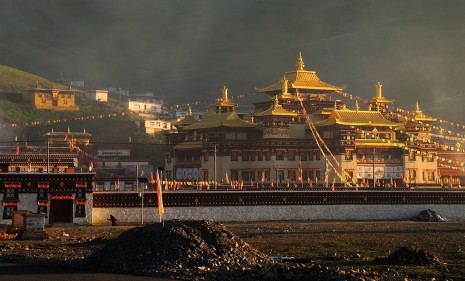
A mile or so from the site of the ceremony was a small solitary monastery – probably Kargyupa. It was said to be very sacred. We went to pay our respects and worship there. A few monks came out to receive us at the monastery gate. Further away was the Gelukpa, Sershul monastery, the largest in the area. The abbots and disciplinarians of the monastery, along with a ceremonial train, came out to receive us. They showed great respect to my father. They were genuinely grateful to him for helping them rebuild their monastery which had been largely destroyed by the Chinese. When the abbots approached us my mother remarked how they appeared to be just like abbots of the “Three Great Seats” the three big monasteries around Lhasa – even wearing the special raven-eye capes, and their tse sha (the caps like Roman helmets) back to front. From the fort, the Sershul monastery was about the distance of Drepung monastery from Lhasa city, or so I thought – but I was only a child then and my sense of distance could have been wrong.
We stayed at Dzachukha for some time. My father requested a Jigje Powo Jigpa empowerment ritual from the Lama Jampel Rolpae Lodroe. Also the precious Dzochen Rinpoche passed by Dzachukha. His monastery was not very far away. He had lunch with us and talked for sometime with my father. He was somewhere between fifty-five and sixty then, and quite stout. His nose was red, but that could have been because of a cold. He was wearing a large khampa style overcoat called the ring-gag. He appeared to be a completely un-selfconscious, unworldly lama – like a real siddha. He was greatly respected by all Khampas, Goloks and other Tibetans. When his servitor came out to the corridor with his tea-cup, our servants and others crowded around to get a drop of the remains (sha) of his tea. I also got a little in my hand and licked it up. In Kham everybody is very pious and I became like that too. I even remember kissing a flag-stone that a holy lama had just stepped on.
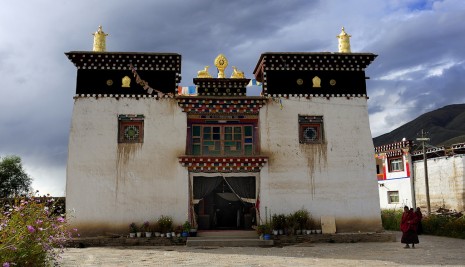
On our way back to Derge we once again stopped at Dankhog, but this time stayed at the Dolma Lhakang or the “Tara Temple”. My father also went to visit the stupa of a very holy lama far up in the mountains, but we children stayed behind at the temple. When he returned my father presented a set of jewel ornaments to an image of Tara there. The temple had three images of Tara, one of which was said to have spoken. Our offering went to this speaking Tara. I vaguely remember the ornament having zi stones and pearls.
After that we returned to Derge.
.
The Goloks rose up against the Communist Chinese occupation army in 1956. In the subsequent fighting which lasted till 1963 their population was reduced from about 130,000 to about 60,000, according to a Chinese research scholar who traveled to the region and published his account in the China Spring of June 1986. The late Panchen Lama, who was from North Eastern Tibet, courageously spoke out about this, after his release from prison. In his address to the Tibet Autonomous Region Standing Committee Meeting of the National People’s Congress held in Beijing on 28 March 1987, he gave a detailed report of the mass killings and imprisonments in North Eastern Tibet. This is what he said about the massacre of the Golok people.
“In the Golok area, many people were killed and their dead bodies were rolled down the hill into a big ditch. The soldiers told the family members and relatives of the dead people that they should all celebrate since the rebels had been wiped out. They were even forced to dance on the dead bodies. Soon after, they were also massacred with machine guns. They were all buried there.”



What a beautiful rendering of a chapter from Tibetan history!
Coming to the present is Lukar Jam At sock from around this vast grasslands?
Could he make history too?
Tsunddru la, We must all ensure that he does. Great support work you all are doing at Dharamshala.
wonderful story….so sad that all my family from derge disappeared and nobody knows about them..
Bit revisionist based on nationalist sentiment. There are plenty of archives where khampas fought within themselves and also fought the aristocratic style suppressive and extortion by Lhasan theocratic government. They could barely made beyond east of Drichu and it was the border when Lhasan government lost its own place and established a pseudo three province government in exile partly used the cultural standing of Dalai Lama. More to understand this confrontation between Independent Tibet ruled by monks and aristocrats with independent chieftains of from the independent Tibetan civilization outside the dark rule of Independent Tibet, Tsering Shakya’s article “Jakpa”, heroic robber whose confrontation with Buddhist theocratic power versus independent Bonpo communities. The atrocity meted out was comparable to story of Chinese given the time and circumstance. Still this is an interesting read while been not carried away by nationalist sentiment which has no solid historical and cultural grounds.
NG
It is revealing to know about the possible popping up of Lobsang Sangay against Tethong because the latter’s insistence on Self-determination – as the best and right choice amongst the confusing choices of the so-called ‘referendum’ that virtually confused and ultimately divided the Tibetan community.
Just as it hard to believe that Gaden Phodrang preferred Lobsang Sangay over Tethong, is it possible that now he has apparently become a liability to the august Lhabrang and therefore to His Holiness the Dalai Lama.
My sources have alerted me to a very disturbing development: His Holiness welcomed and heartily supported the fresh-from Harvard student when he won the election handsomely and sought recognition for him both at home and abroad. But of lately, His Holiness has refrained from the ritual of recognizing and appreciating Sangay’s role.
I was told that the latest incident, when His Holiness, not only recognized him, but blamed without naming him that the Tibetan leadership should avoid double-face at the biggest North American Tibetan gathering earlier this summer in New York. Refering to the Tibetan leadership, the Dalai Lama said, “Saying something (good) upfront, but doing the opposite backstage,” is not good.
Underscoring Sangay’s assertive declaration at hearing at the US capital early in his first term that he is not asking neither for democracy nor opposing Communist rule in Tibet.
Understandably he must haunted by this episode. This self-inflicted fracas might prove to be his Waterloo during the next year’s election.
Tibet supporters in the West, especially in the USA need a leader to, at the least, undo that flamboyant bellicose by Sangay.
The Tibetan electorate should seriously consider his re-electability, and instead chose the only candidate who represent the true aspirations of the majority of Tibetan grueling under the Chinese rule, and who share the birth right of every Tibet worth Tsampa, and one who promises to revive the Rangzen struggle.
That rare daring candidate is Lukhar Jam.
Seeking self-aggrandizement at all cost is very dangerous tread – sadly this has what has become of Mr. Sangay.
My two cents is with his opponent -Lukhar Jam. Don’t waste yours.
During my childhood years we would often hear about the stories about “Theurang” from elders while watching the game of Sho. Its said that one can captures Theurang using the “sho” bowl. “Theurang” I guess named after its size (Thepo aka thumb). The one who captures theurang will always win sho for life.
A scandalous plot to topple the sitting Sikyong by the GP clique? Say it isn’t so Lellkyi Tsho!!
First Karma Chophel, and now Lobsang Sangay? This reminds me of Basil Fawlty when said to Polly, “I’ll ruin you… you’ll never waitress in Torquay again!” I should think, after this, Dr. Sangay won’t even be able to get a job waiting on tables in dharsa. haha
Ok, seriously. Assuming we are not indulging in conspiracy theories, assuming it’s a matter-of-fact that Gaden Phodrang support is drying up for Dr. Sangay. I would be hestitant to suspect the big chill is due to the “no democracy in Tibet” kerfuffle. Dr. Sangay is, after all, a Harvard grad with politics in his blood. (I think he likes politics, I think he is good at politics.) Such an well-informed and savvy politician, you would assume, (unless he is willfully egotistical, or even so) would be sure to have the full support and backing of his coalition (including the GP) before venturing out on any course changes.
After the Washington event, many concerned individuals and few (very few) honest Tibetan journalists and pundits were outraged over the Sikyong’s comments made at the CFR. At around the same time, Kundun was saying a lot of nice things about China and the then newly elected Xi Jinping.
Once again, assuming Lellkyi Tsho knows what the hell he is talking about, assuming this ugly intrigue wasn’t written merely to hype Lukar Jam la and hurt the opposition. Could the honeymoon have ended over the March 10th farce? (And probly over other irritations too besides.)
Shortly after the M10 charade, Gaden Phodrang rewarded the NY/NJ Tibetan numbskulls audience with various heads of Tibetan Buddhism, notably, the Karmapa and Samdhong Renpoche. Meanwhile, Dr. Sangay kept a low profile, didn’t involve himself in the burlesque show, which may have irked Samdhong and co.
I am assuming a lot of course, but let me assume some more.
Makes me think, not withstanding Kundun’s retirement, could it be, Gaden Phodrang has the ultimate power whereas the PM/Chitues have only minimal powers?
Could it be, Gaden Phodang has the Election Commission, Tibetan National Democratic Party, TWA, TYC, etcetera in their pocketses?
Could it be that His Holiness gave us Tibetans democracy so we can impress the injis with our voting rights?
What does Democracy Day really mean to us Tibetans but an excuse to party, and maybe raise a little money?
I should think, no Tibetan who genuinely believes that Tulkus, the clerics, are the natural rulers to lord over all Tibetans (no matter if these types lost Tibet in the first place) would want, or need democracy. It seems to me, that, not equality, but loyality, is most important.
How can we even dream of equality in our society, a society brimming o’er with Tulkus? It’s pure fantasy to believe that such a feudal minded people would ever want to embrace genuine democracy.
What if His Holiness is right and the next Dalai Lama turned out to be really, really stupid? What if the next Dalai Lama was this guy?
https://www.youtube.com/watch?v=C4RLavXngDs
Makes me cringe, yet, I digress.
So, yah, it makes perfect sense than to replace Lobsang Sangay with a yesman(or more loyal man?) Penpa Tsering. I am not accusing Gaden Phodrang of CCP kleptocracy. I am sure, in their own way, they feel they are doing the right thing, for themselves, and for the greater Tibetan people.
I believe (in rare instances) that a selfish, greedy person can also do tremendous good ala Oskar Schindler!! Yet, these Dharsa princes have other agendas. For instance, to foist their brand of Buddhism on the Tibetan people, to hold onto power at all costs.
They are very successful because they always have the intolerant majority, the majority who do not believe in the concept of equal rights for all, at all.
Tibetan exiles celebrate 55th(not 55th day people, that’s YEARS) Democracy day. (Phayul)
Ahh, the beauty of Tibetan Democracy when the people (Gyuto monastery) and the leader (Sikyong candidate Penpa Tsering), exhibit the same wonderful tolerance.
“I will never sit and debate with the Sikyong candidate who is critical of His Holiness. It is very upstanding that Gyuto monastery prohibited any Sikyong candidates who criticize His Holiness. Recently, a Tibetan media invited me to debate with someone that I mentioned above, but I refused because I will never sit and debate with those people.”
http://www.rangzen.net/2015/09/01/a-mind-boggling-statement/#more-6957
“The Election Commission urged the people to extent their help in policing the upcoming elections. They also asked to help them root out those who are not abiding by the laws and those trying to create disharmony within the society through groundless accusations.” (Phayul).
I would be only too happy to perform my civic duty.
“I will never sit and debate with the Sikyong candidate who is critical of His Holiness. It is very upstanding that Gyuto monastery prohibited any Sikyong candidates who criticize His Holiness. Recently, a Tibetan media invited me to debate with someone that I mentioned above, but I refused because I will never sit and debate with those people.” -Sikyong Candidate Penpa Tsering
“Character assassination”, “defamation”,” creating disharmony within the society through groundless accusations”……it’s all there, all being committed, or rather, violated, by Speaker Penpa Tsering and the Gyuto monastery, a clear breach of article 2.
“2: If a candidate or supporters of a candidate resorts to character assassination or defamation of another candidate with intention to sow seeds of discord on the basis of religion, region, community, etc, (if proven) the votes accrued on that particular candidate’s name will be nullified. Moreover, the individual who resorted to such tactics will be denied their democratic rights of voting for the next 10 years.”
So we have following candidate.
1.the highschool kid (tw).
2.the rabsee(alchoholic…PT).
3.the faitbful follower (LJ..no leadership iq).
4.the newbee (who?..tt).
Devil@10
(5) mortgage -paid-by-China , will accept Chinese communist party rule ( Lobsang Kim Jong Sangay)
I will blindly vote for Lukar Jam. Reasons:
1. It is time to send the corrupt Manchurian candidate home.
2. It is time to elect a real patriot who is born inside Tibet.
3. It is not only a vote for Rangzen but also a protest vote against U-maelam crap,
5. If a dummy like LS can serve as Sikyong, anyone can be. Ask his man Friday Pema Chonjor.
Also ask candidate no 4.
I think we are overestimating the role of GP. They want to stay above politics and that is where we should let them be. BTW – Kungo Dhonchoe welcome here. I remember you from your last incarnation.
In your last incarnation when you viciously attack Tethong, you came as Daveno – man ?
This time you are coming as Daveni – as lesbian perhaps?
Anyway , welcome. I have never seen such a vicious group of people like LS and his officials disguised as thugs.
thugs dressed up as officials. ( correction)
Add this latest from RFA regarding its coverage of the Sikyong an Chitue elections. Like Penpa Tsering-Gyotoe fiasco, RFA is reported to have curtail or ban coverage of Lukhar Jam and the like. Word has spread that Gaden Phodrang zealots have overtaken the the editorial management of the RFA Tibetan service – given its trouble which began with Ngago removal. God knows that is Ngabo is doing now!
Sources claim that Mr. Tehong has no control what so over as the director of the service which is being run directly by Gaden Phodrang’s point person under the aegis of the Chinese dragon, Libby amd co. Apparently Tethong has succumbed to pressure from within RFA management so much so that Kalden Lodoe has become the unofficial boss of the Tibetan Service, working in direct collusion with Dharamsala authorizes.
And get this: Kalen Lodoe has managed, gratis of Libby, to hire a girl’s consultancy during the Tibetan election cycle. The Service is under silent shock. Could the lady be his next would be girl friend or possibly second wife.
RFA Tibetan service is getting murkier and murkier by the day, and I would expect it would have explode some day some way. What out folks!
Someone must prosecute penpa tsering for his discriminating statement!
he is unwilling to sit with large part of tibetan community if not the majority! wow!
This is shouldn’t goes with nothing…someone must sacked him out of sikyong race
Again Kalden lodoe and Libby story? What a crap..everyone at RFA is bullshit. They even don’t have guts to speak against this ex-Namgyal Dralok Kalden? Shame on you all the RFA Tibetan Service employee… No wonder Voice of Tibet is more popular than Radio Free Asia with tiny budget…
I agree Voice of Tibet is number one followed by Voice of America Tibetan Service.
Radio Free Asia seems to be catering only to monastic community. It is 90% religion and Lamas, specially since the ouster of former Director. But you go monasteries, they read Khabdha more than listen to RAF . Ask them, many of them will tell you how much they hate this Amdo guy – who does a religious speeches endlessly.
I listen to Voice of Tibet religiously. Voice of America – some program. Radio Free Asia – their news Round Up and Feed Round Up. The program by Ex-monk is predictable, always biased, always about religion or Lamas or religious conference. He is out there to promote his circle of friend. This guy reminds me of the story of the ignorant but arrogant tortoise in a drying well with two beautiful crane.
If you listen to the tone of this guy, it is like listening to a North Korean broadcast. If you don’t know how it sounds, try listening to a North Korean broadcast just for fun.
Radio Free used to have some nice open discussion program with different people. But now the good programs are all curtailed. So much for Free Asia. Many say Samdhong rinpoche is behind it. These people still can’t understand how much Tibetan society has opened up. Are they going to appeal to Tibetan youngsters not to read English !
if kalden lodie favors any Sikyong candate, we will destroy the existence of RFA Tibetan service. Mark our words people in Radio Free Asia including Chinese prostitude Libby.
Radio free Asia baning lLukar Jam is beyond their ethics. We the supporters should write complain letters to their administration United states broadcasting board of governors. http://www.bbg.gov
And to reporter without borders.www.rsf.org
Just so sad to hear about lack of tethong’s influence due to backdoor kalden lodoe’s drama ring with gad hen phodrang! This is a tragedy for the ltibetan media history and it will only hurt ourselves.
What are we all doing to elect Lukar Jam? Did you try to talk to your friends and relatives to vote for Lukar? Did you donated fund? Did you write something about Lukar on your Facebook or anywhere?
Yes, speaking against unfair media coverage this time should be brought to the highest authority in USA as well as in other media.
Yes, Tethong is just useless pawn in RFA. Thank god we did not elect him for Skyikong..this guy does not even have balls..hahaha
Everyone in RFA Tibetan section shits in their pants when they see or hear big boss
Kalden Lodoe..the chief editor and chief cham cha..
The Kundun Hater Vs the Murderer?
It’s discouraging that one of our illustrious candidates to the highest office, Penpa Tsering la, fueling the elections with fumey innuendos. The highly prejudiced Election Commission may disagree with me, but this is setting a dangerous precedence which could irreparably damage the elections. The EC need to find their balls and quash such pernicious demagoguery before it gets out of hand!
And, as the EC was kind enough to solicit public participation, may I humbly suggest legislating an edict whereby electoral candidates are prohibited from mentioning His Holiness? Again, just last week, His Holiness said he is retired. So, in the interim at least, the candidates should leave Kundun out of their political discourses, rather, let the Tibetan people hear what you are bringing to the table. I don’t know who loves, or hates Kundun. I really don’t know whats in people’s hearts, but it’s hard not to notice Tibetans, and especially Tibetan politicians, using Kundun’s good name to say and do bad things.
I’m sentimental as the next guy, but ultimately, sentimentality will never be enough to construct a vibrant civil society if the foundations are not build upon the concrete.
A beautiful piece of history before all the misery and heartache befell our sad country. You can feel the innocence of the period and even time seem to have obliged one last time to prolong this moment before the inevitable onslaught of history.
Lukar Jam is far sopisticated and better educated than Harvard trained Sikyong Lobsang Sangay.
Recently someone alerted me to read a condolence message by sikyong to President of India Pranab Mukherjee on the passing away of his wife. Oh man, my high school kids can write one far better than that.
What is most painful reading it was that, it did not sound authentic at all.
If this is the standard of Harvard University, I think many colleges in India are doing avery good job! But , of course , not one where Sikyong Lobsang Sangay went to study.
Or did he really go to study or was busy watching JP road or peep show in America? What a pathetic , tragic figure we have for past four years, always lying to His Holiness the Dalai Lama, forget about lying to poor Tibetan masses.
But then, he had a very clever explanation. He is saying to everyone that whatever he did, he always consulted Samdhong Rinpoche. Disabanding Task Force, Samdhong Rinpoche! Giving crooked response to Parliament, Samdhong Rinpoche! Oh man.
Dear Jamyng la,
I loved reading it. Yet another very beautiful and vibrant construction of Tibet’s history in action. I remember your Amala Dampa from my childhood days in Kalimpong and thereafter. A very gentle and peaceful lady with a grace of her own.
Thank you,
Tsepak Rigzin